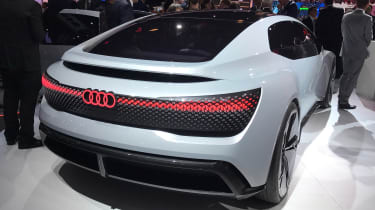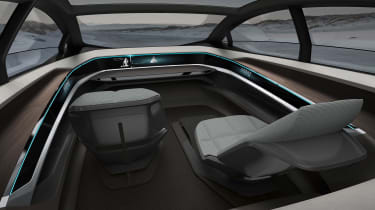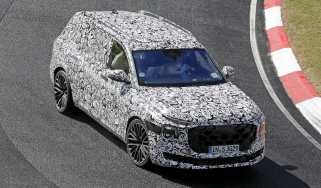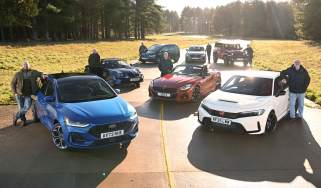Audi Aicon autonomous pilot fleet to launch in 2021
The Audi Aicon concept will be used as the basis for future autonomous cars, with a pilot fleet launching within three years
Audi will launch its first pilot fleet of autonomous cars in 2021, with the vehicles based on the Aicon concept first shown at last year’s Frankfurt Motor Show, Auto Express can reveal. The news was confirmed by company boss Rupert Stadler at the launch of the all-new Audi Q8 SUV.
“Our vision of the new premium is why – in just three years from now – we will present our first autonomous pilot scheme,” Stadler said. “This fleet will be based on the Audi Aicon.”
The project will mark 50 years of Audi’s famous ‘Vorsprung durch Technik’ mantra, which translates in English to ’Truth in Engineering’. Few further details have been revealed, although the Aicon fleet is expected to boast the most advanced level 5 ‘hands off, eyes off’ autonomous features. This will allow drivers and passengers to effectively switch off behind the wheel – completing menial tasks, or even “have a nap”.
“So autonomous cars make our customers feel more autonomous as well,” Stadler told us. “This is where we expand our leadership in autonomous driving.”
The Aicon is fully electric four-door 2+2 designed to showcase the firm’s future styling direction and fully autonomous Level 5 driving. It also gives us an idea of how the brand will approach interior packaging when there’s no need for a steering wheel or pedals. Due to the fact the 2021 pilot test fleet will require some level of human interaction, the vehicles used in the test fleet will be adapted to include more conventional dashboard controls such as a steering wheel and pedals.
At 5,444mm, the Aicon concept is around 20cm longer than Audi’s A8 L limousine. The car, which can travel around 500 miles on a single charge, is a demonstration of how Audi could use the VW Group’s all-electric MEB platform, originally previewed by the VW I.D. concept. Aicon takes the architecture to new extremes, though, with a 3,470mm wheelbase - again, around 20cm more than the long-wheelbase version of the latest-generation A8.
• The ultimate guide to driverless cars
No powertrain details for the pilot cars have been revealed, but last year’s concept car used four electric motors, one on each wheel. That meant a total of 349bhp, as well as 550Nm of torque. The concept does most of its braking through energy recuperation, so its disc brakes have been relocated further away from the wheels and closer to the electric motors themselves. This set-up reduces unsprung mass and removes the need for air cooling at the wheels, which causes wind turbulence and drag. The all-electric system has also been used to give the car an incredibly tight turning circle of just 8.5 metres - smaller than that of most city cars.
The concept car sits on 26-inch wheels and features an inverted hexagonal grille at the front. It’s a design motif, which Audi says will be repeated on its future electric production cars. The car does without conventional headlights, too; Audi claims that the plethora of sensors and autonomous technology will negate the need for traditional road-lighting illumination. Instead, it has ‘eyes’ that can react to and interact with pedestrians and other road users - much like the I.D. hatchback.
Audi’s vision also uses a projector to light up the road where necessary and project signals to those who may not have line of sight to the car. The Aicon does recognise the need for light when you’re walking away from it, however; it dispatches a mini-drone to light your path if you’re exiting the vehicle after dark.
The Aicon concept also features rear-hinged doors at the back, and does without a conventional B-pillar to allow easier access to the pair of seats that are integrated into a rear bench. The front seats, meanwhile, can swivel up to 15 degrees, facing towards the outside of the vehicle to make it easier to get in and out, or towards the centre of the car for a more sociable layout that encourages conversation. The seats can move up to 50cm back and forth; they sit on carpeted panels instead of conventional rails, so the occupants feet move along with the floor beneath them.
As there is no steering wheel and no pedals, the Aicon has an unbroken wraparound dashboard that stretches right down each side of the cabin. The panel lights up when the passengers enter the vehicle, and the car’s personal assistant - PIA - recognises the occupants by their telephones and loads personal settings. The touch-sensitive panels also incorporate controls for the air-con and the seating configuration - but the car can also respond to inputs using voice and eye tracking. It’s highly likely many of these features will find their way into the road cars, too.
In addition, there is a considerable boot of around 660 litres - a further demonstration, Audi claims, of how the all-electric platform offers packaging advantages, because of the shortage of mechanical components.
What do you think of Audi's vision of the future? Let us know in the comments below...
Find a car with the experts









